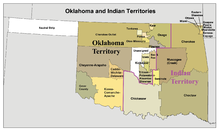Oklahoma Enabling Act

Oklahoma Enabling Act is a US law that was signed by US President Theodore Roosevelt on June 16, 1906. The law made the establishment of the US states Oklahoma , New Mexico and Arizona possible . The law laid down the legal basis, conditions and electoral procedures.
development
The state of Oklahoma should arise from two territories, on the one hand from the Oklahoma Territory , on the other hand from the Indian Territory . Originally, the residents of the Indian Territory resisted unification with the white-ruled Oklahoma Territory and sought their own state. They planned their own state called Sequoyah , named after Sequoyah , the creator of the Cherokee script . The Oklahoma Enabling Act had to finally bury this dream, as the president spoke out against the creation of two states in the area of what is now Oklahoma. Originally, Arizona should also be included as a common state in the USA. However, this was made dependent on a referendum. With the Oklahoma Enabling Act , the Indian reservations of the so-called Five Civilized Tribes in eastern Oklahoma should be dissolved. Only the Osage reserve was to remain in existence. The Osage did not get the reservation through a treaty between the United States and the tribe. They bought the land from the Cherokee and were in a stronger position than the other tribes. The Oklahoma Enabling Act stipulated that the reservation should be in its own county.
New case law
On July 9, 2020, the United States Supreme Court ruled that the Oklahoma Enabling Act did not mean the dissolution of the reservations. In the judgment of Sharp v. Murphy was determined that the tribes continue to legally control the former Indian territory. The ruling reversed resolutions of the Oklahoma Enabling Act and declared 47% of Oklahoma state, including the city of Tulsa , Indian territory. The decision affects around 1.8 million people, including the 400,000 residents of the city of Tulsa. The decision has consequences for tax and criminal law. The ruling does not change ownership of land and soil.
References and comments
- ↑ Oklahoma Historical Society ENABLING ACT (1906)
- ^ Oklahoma Historical Society: Sequoyah Convention
- ↑ Osage Nation: On July 15, 1870, the Osage Diminished Reserve was sold at $ 1.25 per acre to the US The funds were placed in trust with the US government allowing the Osages to buy a reservation in Indian Territory; land held by the Cherokee Nation was purchased for $ 1,099,137.
- ^ Oklahoma Historical Society: Osage County
- ^ Frankfurter Allgemeine Zeitung, Supreme Court decides: Half of the state of Oklahoma is an Indian reservation
- ↑ BBC US Supreme Court rules half of Oklahoma is Native American land
- ↑ businessinsider.com Supreme Court rules that a large portion of Eastern Oklahoma is Native American territory
